Part of my Series on Fountain Pen Sketching – click here for the index,
After looking at some basic fountain pens in Part 5 we will now look at some pens that give greater line variation. This is the ‘hot topic’ when it comes to fountain pen sketching and my goal is to provide an introduction to the main options. This is very much a work in progress – I have learnt a lot putting this together but have still more to explore – much more.
There are three main types of nibs that provide significant variation:
1. Flex nibs
2. Brush tips
3. Calligraphy nibs including stub, parallel and fude.
Of course there are more alternatives than I am able to cover, but I hope this will be a good starting point!
But before I get into each one, I just want to clarify a few terms that I will be using.
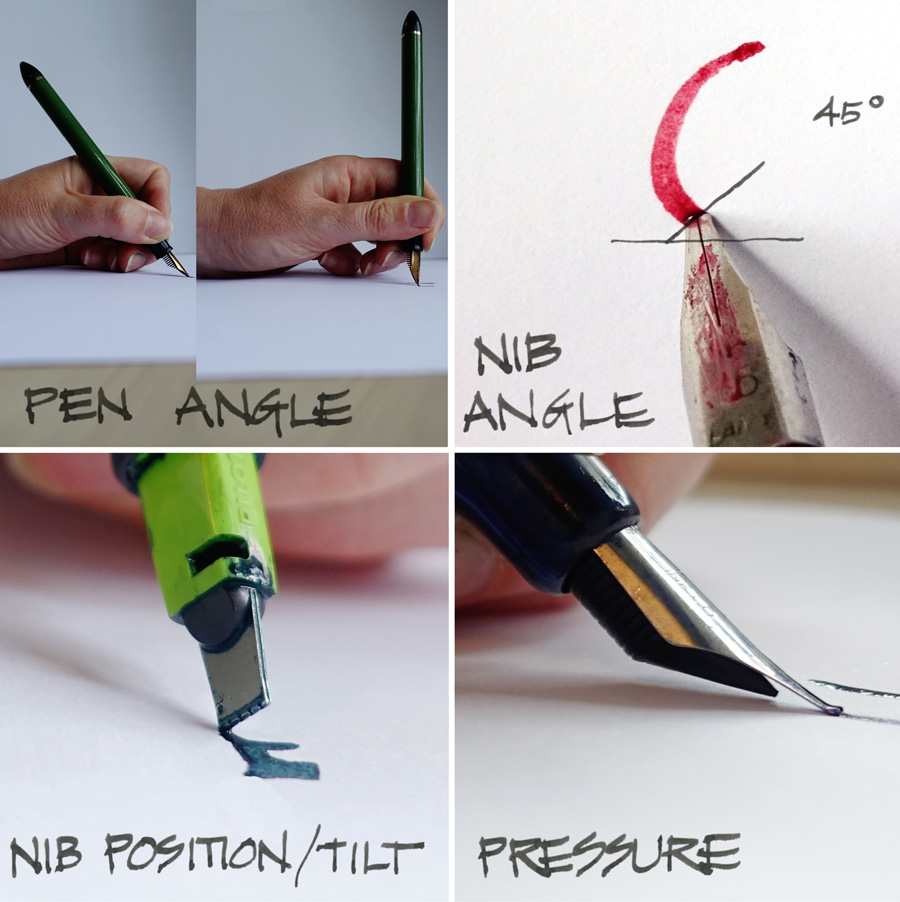
Pen angle: As we have previously discussed, fountain pens are typically best used by holding them at 45 degrees to the page but some nibs create variation by changing the angle of the pen while drawing.
Nib Angle: This is the angle of the nib in relationship to the horizontal. For example a calligraphy italic nib is designed to write with a nib angle of 45 degrees.
Nib Position or Tilt: For want of a better term, I am referring to how the nib hits the page in a non-standard way generally caused by tilting or twisting the pen – for example using a nib on its edge so that not all of the nib ‘tip’ is evenly on the page.
Pressure: Obviously you all know what this is, but I am not referring to pressing really hard! Some nibs flex to allow more ink onto the page producing a thicker lines and other nibs are less responsive to pressure. Be very conscious of how the nib is responding and make sure you don’t bend the tines.
This might seem a little technical but it is these movement variations that create expressive lines!
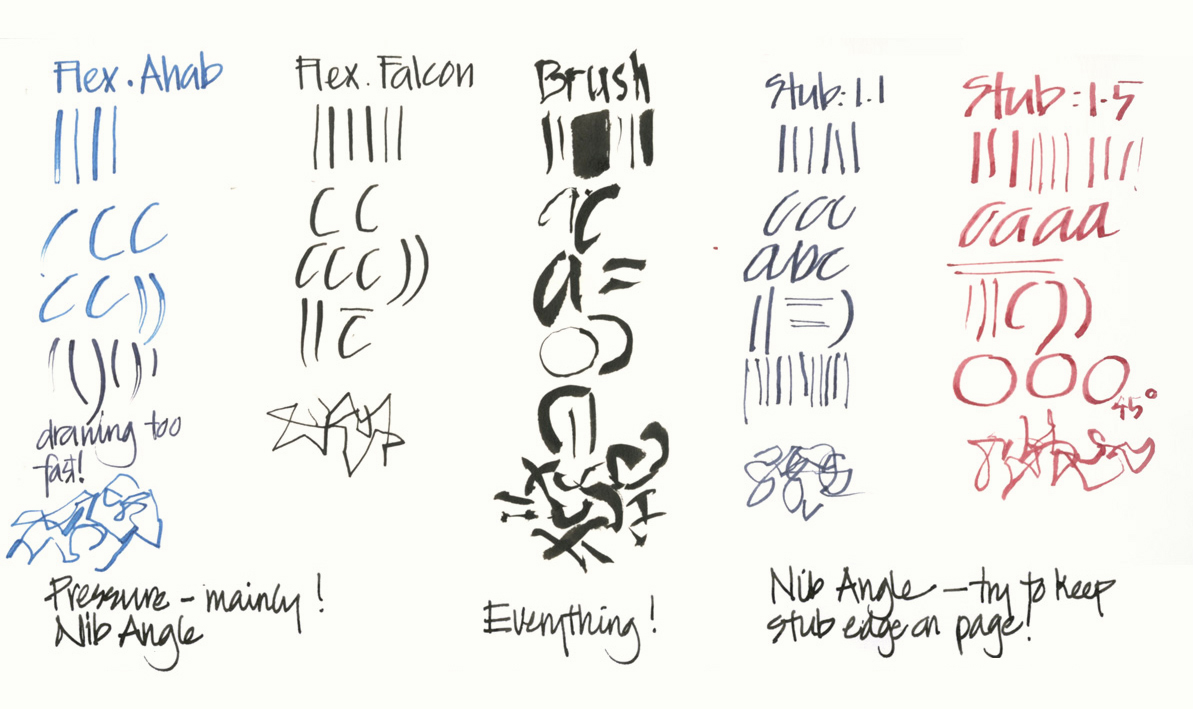
Here are two summary pages exploring which movements are the most relevant to the pens I will be testing. For me the big issue is working out which type of movement will suit my sketching the best!
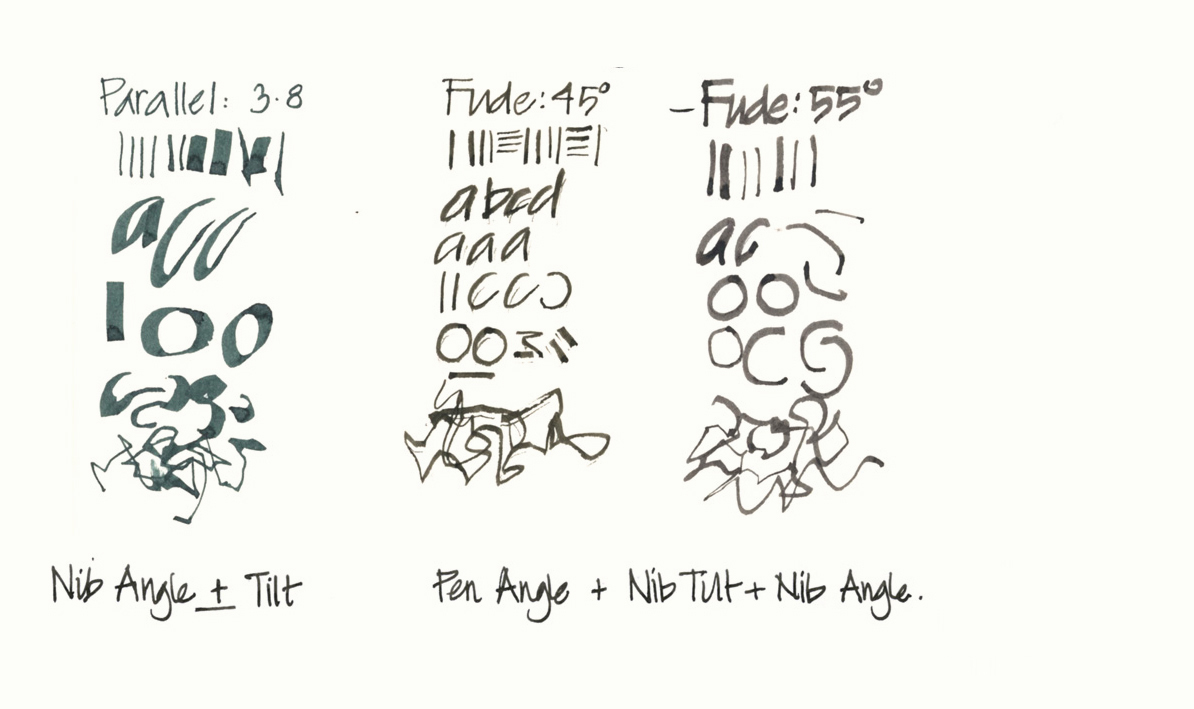
A big part of the joy of using fountain pens is learning what they can do and then exploring if you can use this to advantage in the way you sketch. This involves a separate creative journey with each pen – it is not an instant magical transformation of your lines! Enjoy this process of discovery!
Aside: I was watching this video about ‘breaking In fountain pens’ yesterday. I really like what Brian says about the pen ‘breaking you in’ rather than the other way around. The important mental attitude to have is a desire to work with the ‘sweet spot’ of a particular pen rather than being totally dismissive of it after one use!
Just a reminder that there is a Shopping Guide on Goulet Pens for all the pens that they stock that I refer to in these posts. And also a special discounted bundle of the Lamy Joy pen. For comparison purposes I have included the current list price* of each pen but please check the price on Goulet Pens’ site. Just a reminder that this is not a sponsored post nor are there any affiliated links. Please feel free to do your own searches for the best deal in your country, but I do recommend that you follow the links to Goulet Pen’s site so that you can read customer reviews and watch Brian’s videos.
For Australians – I recommend you check out Larrypost who also have a special Joy bundle at the moment.
Flex Nibs
There are a lot of people looking for a fountain pen with a flexible nib that produces a similar result that you can get from a dip pen. This is a very involved topic and one in which I am certainly not an expert, so what I will share is my current thinking – and I hope that readers that are more expert on the topic can add to the discussion in the comment section.
For me using a dip pen is as much about the variation in the ink supply as it is about the flexible nib. In a fountain pen the feed is designed to give an even flow of ink to the nib so this is inherently a different experience from dipping into an ink bottle and creating lines that have a dramatic fall off in ink. In my research it seems that vintage pens have a degree of flex that modern pens can’t match: however modern pens are more reliable. So if you want a true flex pen you either need to go down the vintage pen route or investigate customizing a nib. This is all getting into the realm of serious fountain pen stuff – so I will leave that for further exploration. BTW Brian Goulet discusses modern vs vintage flex here.
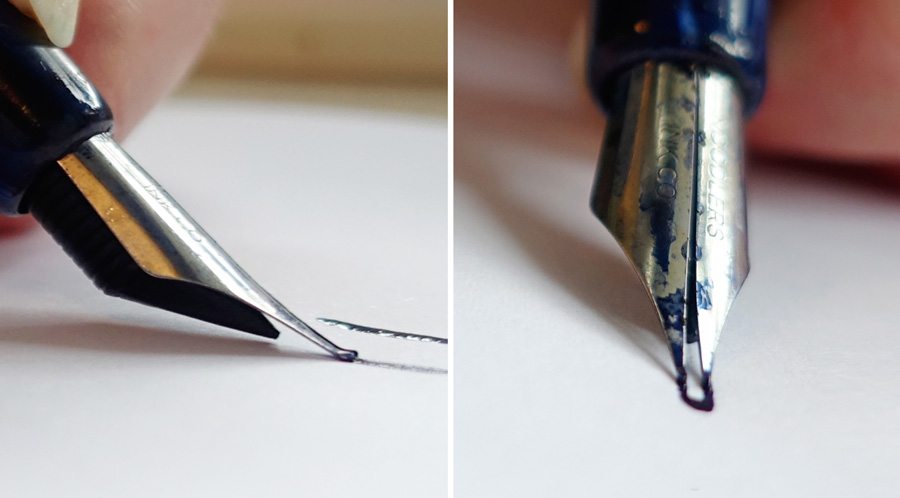
The whole idea of a flexible nib is to apply pressure so that the tines of the nib separate and more ink is released onto the page. Increasing pressure for a thicker or stronger line is a fairly natural way to draw (eg. with a pencil) however when you’re using a fountain pen there are additional considerations. You have to be aware of the angle of the nib and how fast you are drawing the line so that the feed can deliver the ink that is required. If you go too fast and the feed can’t supply enough ink you will get a railroad track effect (as per the photo above).
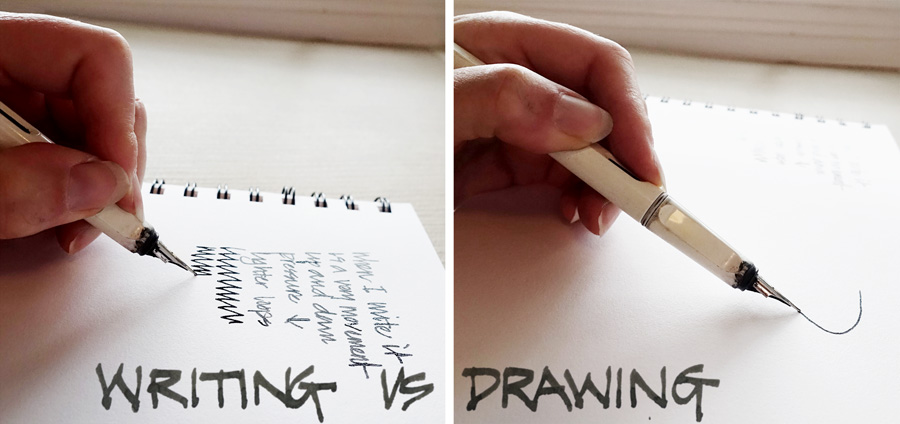
As I have mentioned before, I find it a lot easier to get consistent flex when I write than when I draw, as the rhythmical up and down movement of writing makes sense with varying pressure (heavy down strokes, light upstrokes). Sketching is a lot more complicated with more varied strokes and different situations (working fast or slow, gestural strokes vs fine detail). Another factor to consider is how much ink sits on the paper when drawing thicker lines and what drying time is needed.
So it is not just a case of finding the ‘perfect’ pen, it is all about having an understanding of how the pen will work with the way you sketch.
Right at the moment I am still exploring how to get the most out of using a flex pen. I am finding the application of pressure while I sketch is affecting my spontaneity of line – it is certainly not flowing naturally. I am also training myself to adjust the pressure mid-line to get the most out of the flex experience.
Now to get onto the pens…
Flex Pens:
1. Noodlers Flex Pens
2. Pilot Falcon (previously Namiki Falcon)
3. Gold Lamy Nib
Brush Pens:
4. Pentel Pocket Brush Pen
5. Noodlers Konrad Brush Pen
6. Platinum Weasel Brush Pen
Flex pens
1. Noodlers Flex Pens
Current List Price* ~$16-40
Full Range of Konrad and Ahab pens at Goulet Pens here
Full Range of Nib Creaper at Goulet Pens here
These pens have been around for a little over 5 years and although I got one of the early Nib Creapers (the little blue pen in the middle) and then subsequently bought two Ahabs, I haven’t really used them much. The Nib Creaper went through the ink too quickly and I had trouble with both Ahabs – I just couldn’t get them flowing properly (or even starting!) However when Goulet Pens sent me a Konrad to test (the clear demonstrator) I was determined to have another go. The Konrad is a much better sized pen for me so I filled it with ink and eagerly started to use it. Once again serious flow issues… until I did some research and discovered that the number one rule for using a Noodlers pen is to give it a good flush before you start to use it. So I cleaned all my Noodlers pens with the Goulet Pen Flush, and guess what? – they all work really well now!
The big thing to realise about the Noodlers Pens is that they are incredibly affordable flex pens, but they do sometimes need a bit of adjusting. Don’t buy one if you are expecting the most reliable pen on the market – but the adjusting isn’t such a big scary procedure and there are great Goulet videos to walk you through it! The other thing about the Noodlers pen is the very strong smell caused by the resin used for the pen body – I am not a fan of it but it doesn’t put me off using it.
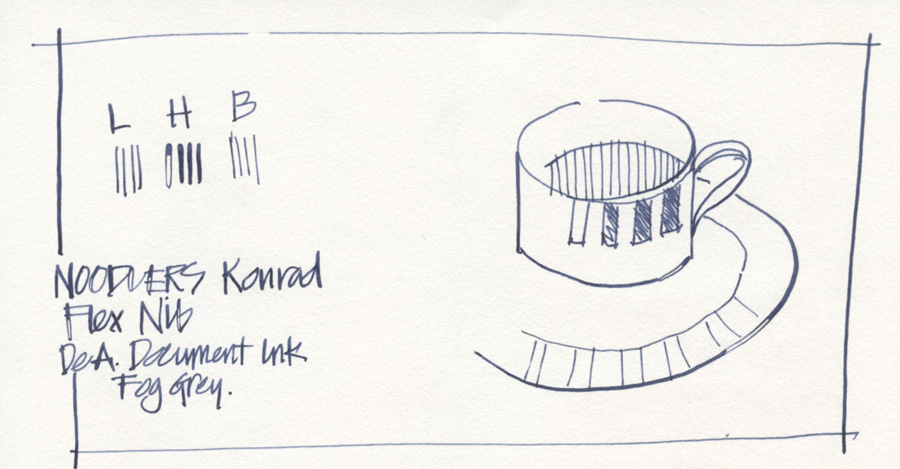
Now that I have got my Noodler’s pens up and running I am learning how best to use them. In essence the flex is good and I am able to sketch quite comfortably with them. The major challenge for me is to work out the best speed and angle with which to use these pens.
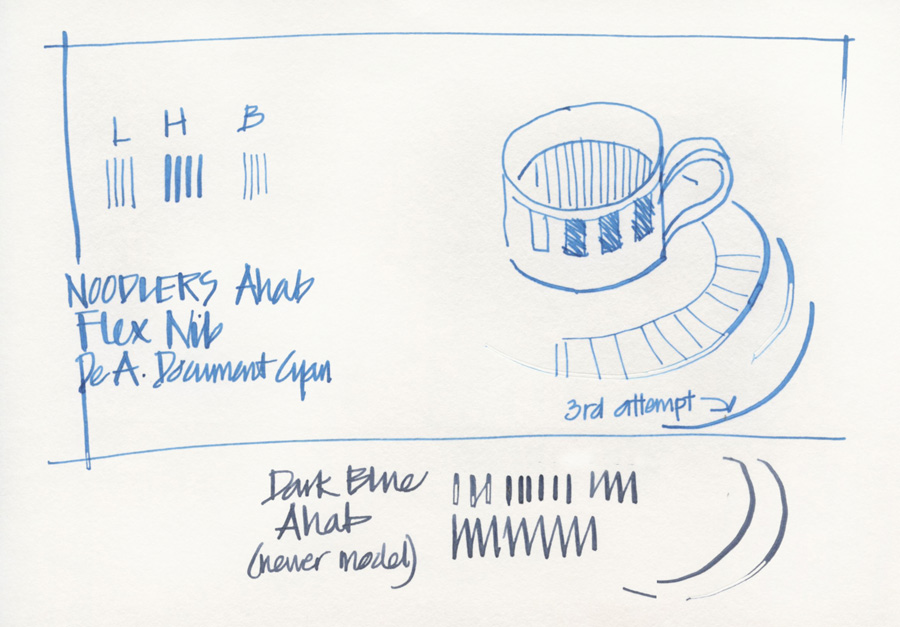
For some reason I am getting lots of railroad tracks when I do my pen tests, but not so much when I sketch. I know that I have to slow my pace when I want a thicker line… but sometimes it is hard for me to slow down – ha!
2. Pilot Falcon (previously Namiki Falcon)
Current List Price* ~$145
Full Range at Goulet Pens here
Now the pen that everyone wants to talk about is the Pilot Falcon. At around $140USD it is an expensive pen and I have been resisting buying one for the last 12 months. I have the advantage of being able to test Jane Blundell’s pens from time to time, as a way of assessing whether it is worth the expense – ie. whether the flex I can get from this pen is really worth the cost and whether it suits my sketching style. In the end I weakened!
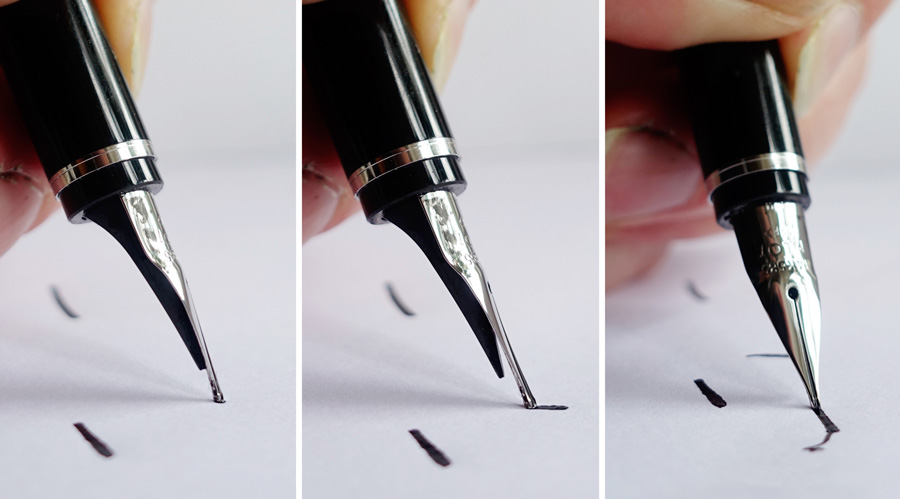
I have only recently realised that the Falcon pen does not have a ‘true flex nib’, rather its gold nib is classified as a ’soft nib’ – it does flex but not in the traditional sense. So in a similar way to my Lamy Gold nib (more of that in a moment) because it is soft you get line variation, but the tines are not separating like they do on the Noodlers nibs. I now have my eye on a Pilot FA nib (which is different from the Falcon pen) … but that is another story entirely and getting too technical. The main point being that I have to be careful not to flex the Falcon pen too much since it isn’t designed for that!
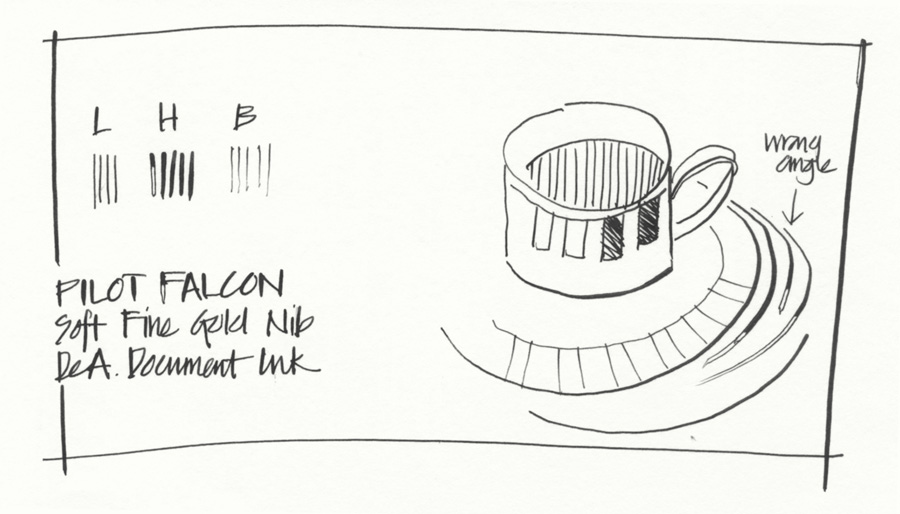
To get back to the Falcon – it is a beautiful pen producing a great consistent flow and some nice line variation – but it is not a huge variation and it is not quite as much as I can get with the Noodlers Ahab. On the other hand it is a softer nib and a much nicer pen to hold and use! I have been putting some good pressure on it, but am very careful not to overdo it. I feel much more relaxed ‘going for it’ with the Noodlers nibs!
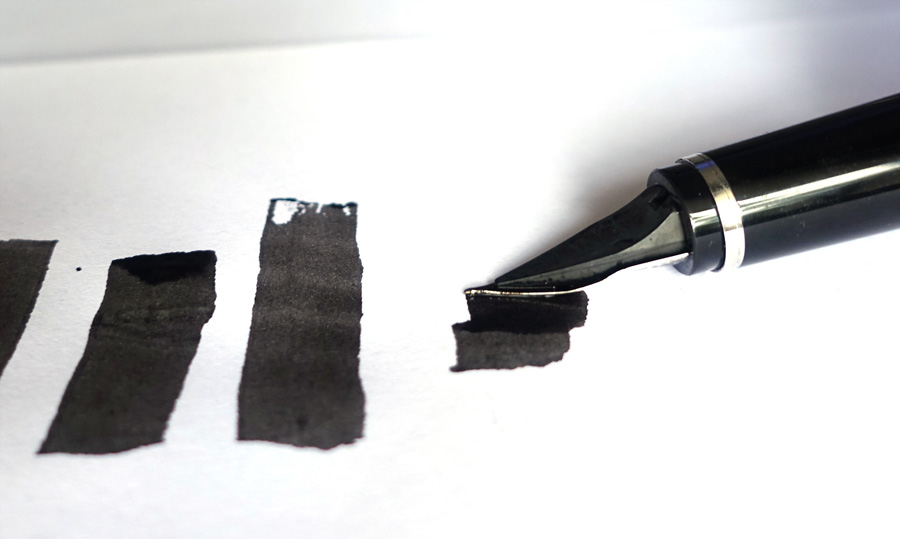
Another great feature of the pen is the flat top to the nib – you can use the back of the nib for a crazy broad stroke.
I will be coming back to the Falcon later… so keep reading!
Other Links
Review by Parkablogs – he has a modified version of this pen with more flex
3. Gold Lamy Nib
As most of you know, I have a gold nib in my grubby Lamy Joy pen. I bought it years ago when I began sketching and wanted the best tools to start with! This nib only has gold down the tines but this does help make the nib more springy. Correction: this gold nib has plating over the top as a design feature. It is more of a soft nib than a flex nib. The main thing about this nib is that it has had a lot of use – 80 sketchbooks worth of drawing at a guess – so the flow and wetness is as much a result of usage as is the gold.
I know that the gold nib is difficult to get separately in the US but here in Australia you can easily buy a gold nib to put in any Lamy pen.
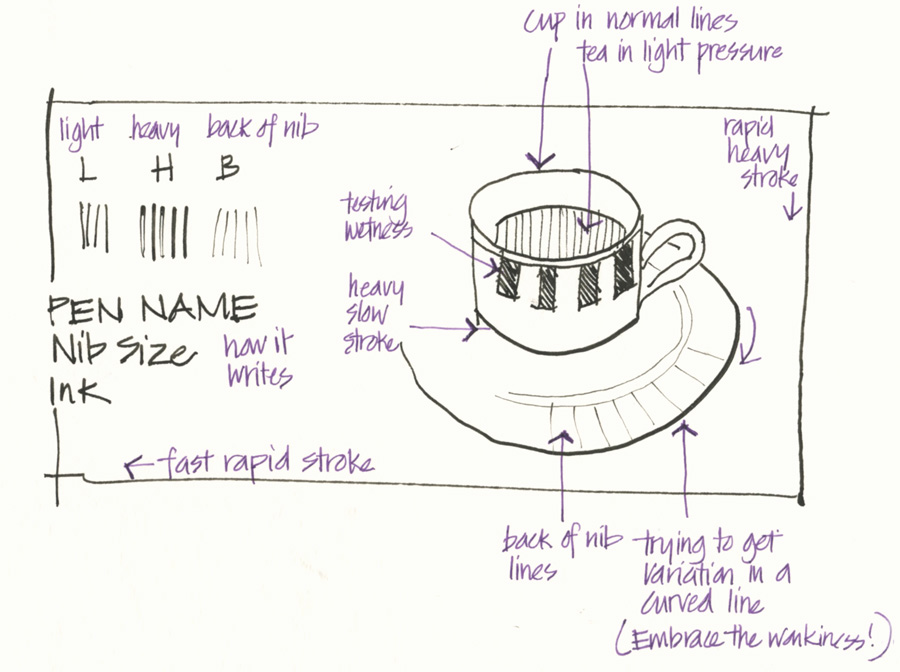
Here is a quick test of my gold Lamy nib. I can get good variation in line thickness by applying different pressure but it is hard to vary it while I am drawing a line. So I don’t get as expressive a line as I can do with the Noodlers or Falcon pens which are much more responsive.
Do I recommended it?
Well.. it is perfect for me as I am so much in love with the Lamy Joy pen body so it gives me the best nib option for that pen. But for the price and the variation it offers I don’t really think it makes a lot of sense for others – I think the Falcon is a better option.
So what’s the bottom line – is the Falcon worth it?
I know a lot of you are waiting to hear what I think of the Falcon but it is still too early for me to make a definitive statement. Stay with me until I have done my review of the Fude calligraphy nibs because I have some interesting comparisons to share.
I do think that the Noodlers Konrad is a good pen to buy if you want to explore sketching with a flex nib first before making the big commitment of a more expensive pen.
And oh – here is another Goulet video to check out about the difference in flex between the two pens!
Brush Pens
I will be much briefer with my comments on these pens as this is a little tangential to the general focus of this series. Brush pens create quite a different look – I like them for occasional use but rarely incorporate them into ink and wash work.
In essence you can get the most variation by using a pen with a brush tip, but these also require the most amount of control. I am still very much a beginner when it comes to using these pens to their full potential – which is using them with careful control calligraphic strokes. I love having a few tools that I can grow into – ones that I can currently use to effect but also know that there is a much more sophisticated usage of them that I can explore down the track.
Aside: I did a wonderful workshop with Melanie Riem at the Urban Sketchers Symposium on this topic.
4. Pentel Pocket Brush Pen
My own usage of these pens is for loose gestural strokes and I have been using the Pentel Pocket Brush Pen (with cartridges) for years. It is a great pen but I wanted to explore some options for using fountain pen ink.
So I now have a Noodlers Konrad brush pen and a Platinum Weasel Hair brush pen.
5. Noodlers Konrad Brush Pen
Current List Price* ~$20
Full Range at Goulet Pens here
Once again I had a little initial trouble with the flow of the Noodlers till I cleaned it and now it is working better. I find the flow of ink is less than the Pentel but if I go slow the flow is adequate. Need to use it further to check its performance over time, but it is certainly not as good as the other two alternatives. I have already put a permanent mixed grey ink into it which is what I have been wanting to use for a long time.
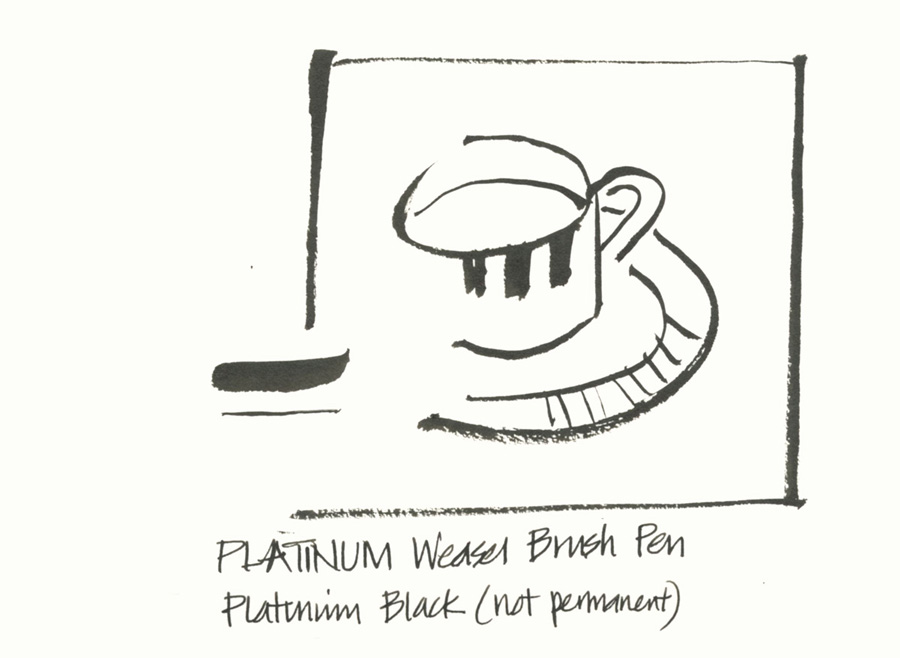
6. Platinum Weasel Brush Pen
Current List Price* ~$65
Full Range at Goulet Pens here
The Platinum Pen is much superior and has a great flow – this is exactly what I was looking for. It is a much more expensive pen though, but I very happy with this purchase. As it is a natural hair brush tip I am going to do some more research into putting pigmented ink into it – so for the time being I am sticking with fountain pen ink inside it. I will be exploring all kinds of ink options in the Konrad Brush Pen though!
In summary: the Pentel Pocket Brush Pen is a very good option and if you want to get into brush pens this is the pen I would recommend!
And… as the first person to comment has reminded me you can also use waterbrushes filled with ink!
Other Links:
Fantastic comparison review on Parkablogs including links to further reviews
Jane Blundell on brush pens – including a Kuretake version
Ok… the Fude pens are coming up soon in Part 7!
Once you have a fountain pen you will have to start drawing with it!
If you would like to learn the fundamentals and start urban sketching please check out my Foundations online course.
Subscribe to my mailing list for my monthly newsletters for first news of new courses and face to face workshops in Australia (and overseas!)

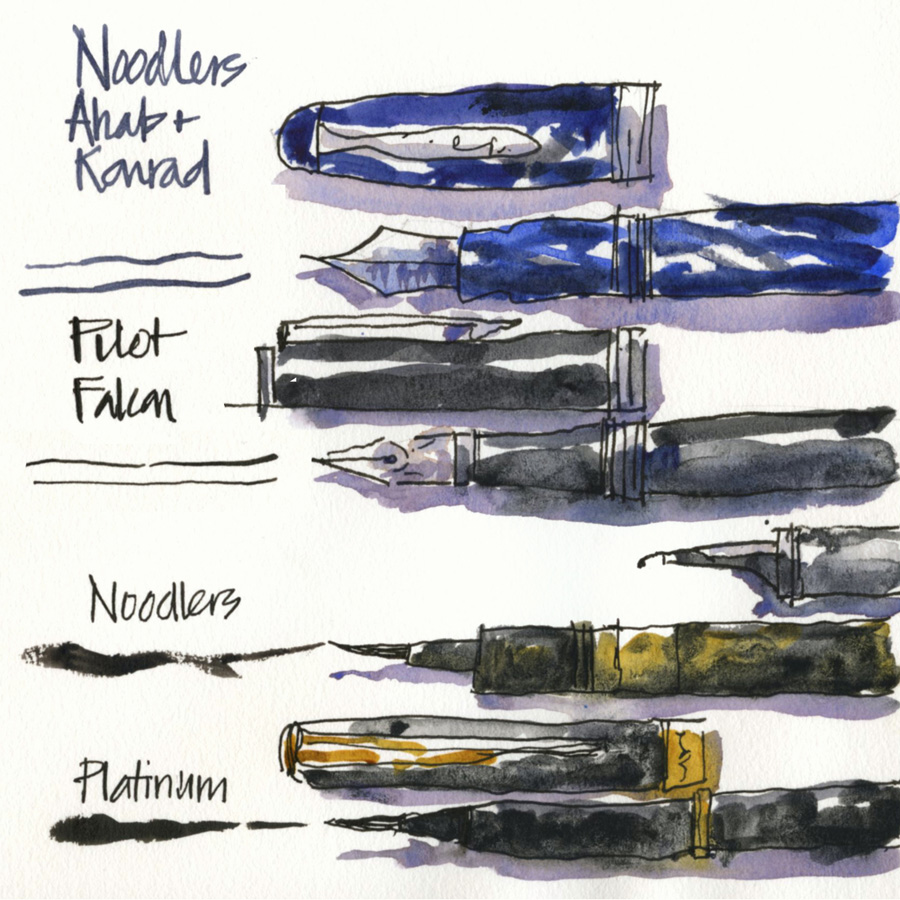
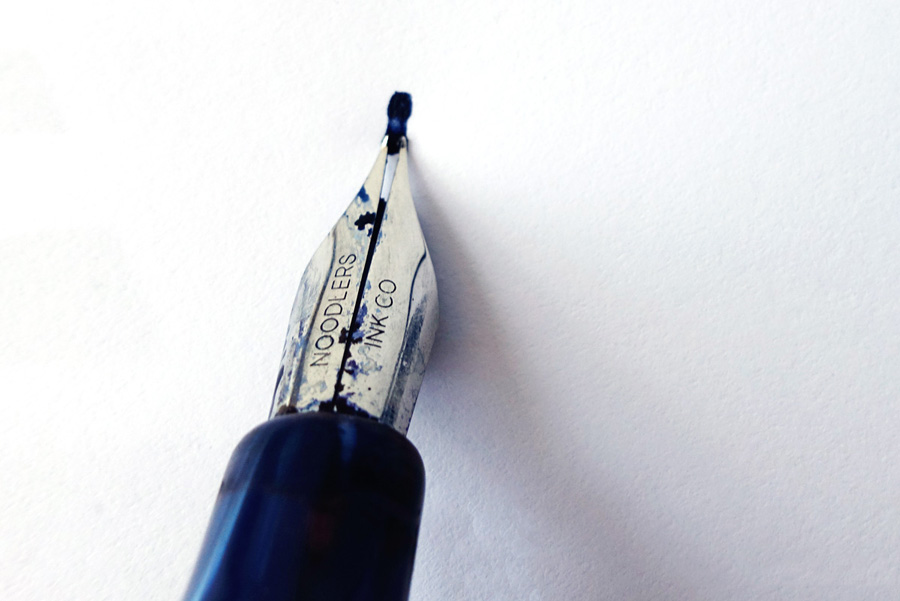

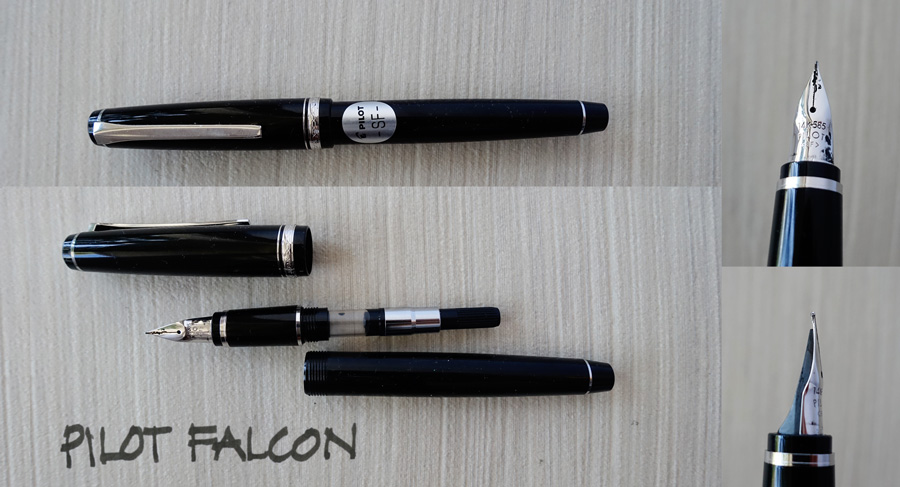
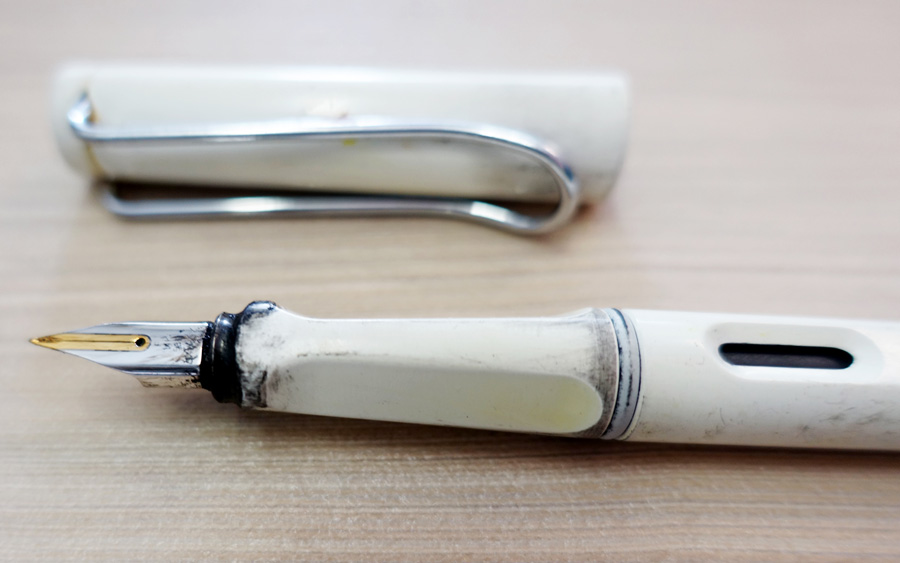
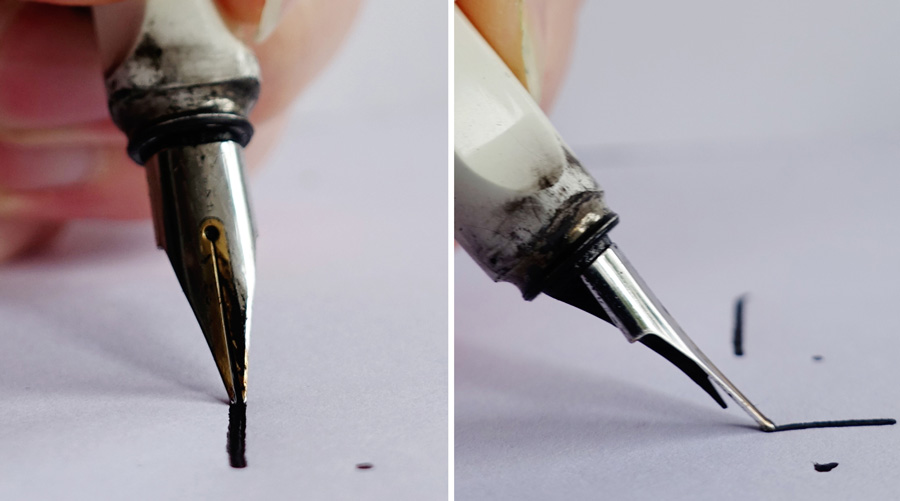
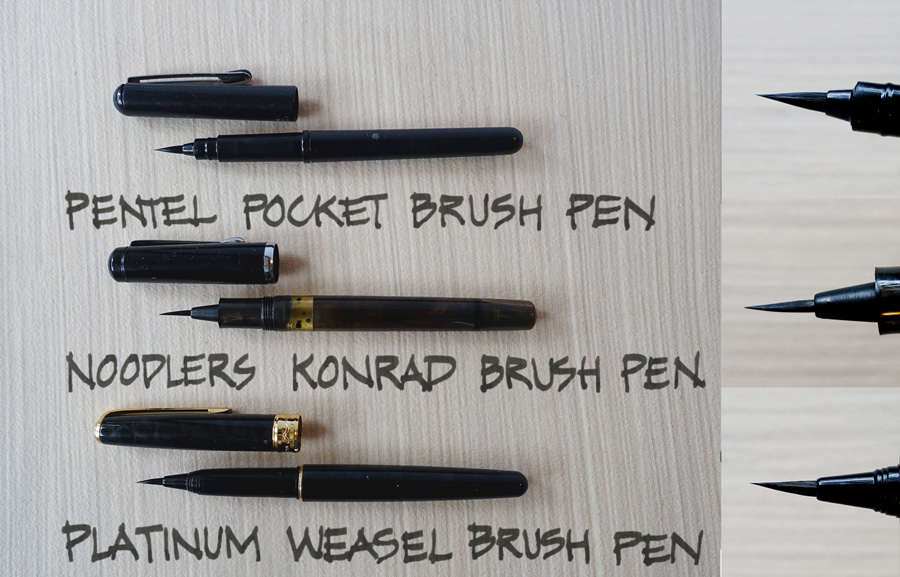
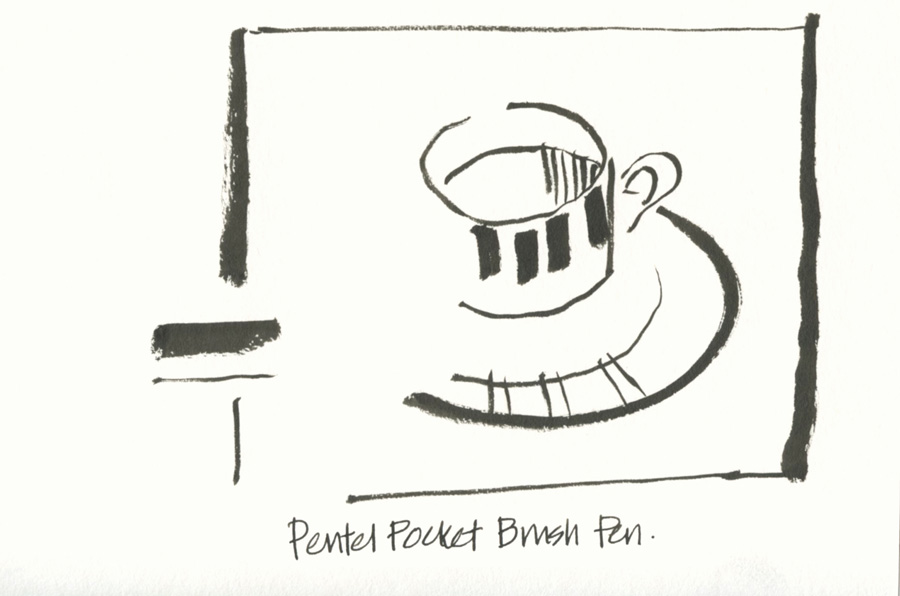
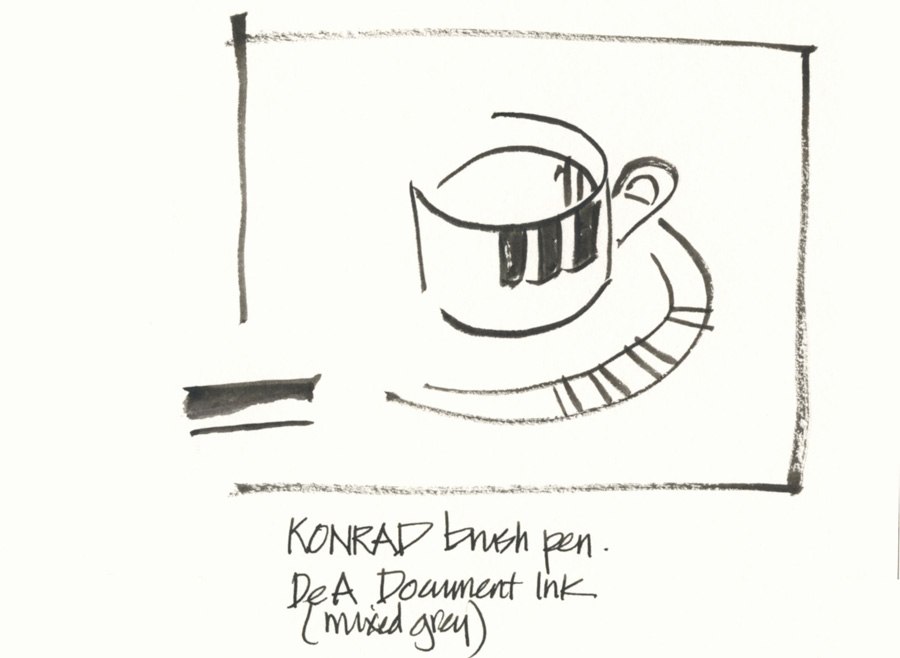



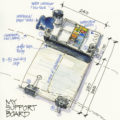
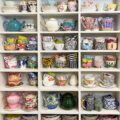

31 Comments
thank you Sketchbook Blue… got my head so much in fountain pens that I forgot about the waterbrush…so just added a note about that.
This series is a full time job for this month (I hope to share more about the process later))
Absolutely glued to this series, Liz already learnt a whole lot, as I'm not very familiar with pilot pens. That Pentel pocket brush, though, had been with me through a lot. 🙂
its the separation of the tines so you get extreme variation…will come back again to this in part 7
Have fun with your Kaweco!!!
thanks PJ – so lovely to have you following… and you would be a master of the Pentel Pocket Brush!!!
Great post. I recently got to try out a Kaweco sport and found out that one can get quite a bit of line variation with the right pressure. What makes a pen a flex pen?
Thanks for another great installment, Liz. I bought my first Noodler flex nib from Goulet earlier this year, along with a Noodlers brush pen. Have not had good luck with either — constant flow issues and clogging. Sounds like another clean out is in order, and perhaps I will try again?
For my style, I think I prefer leaving the brush out of the pen, so to speak…using the pens for lines and applying wash separately. I have used a few brush-headed markers, but they just do not offer the pleasure of the fountain pens.
Mostly a Lamy girl, but I just ordered a Kaweco to try….
I have been greatly enjoying this fountain pen series. I'm glad you mentioned the need to clean the Noodler's pens before use. A gentle scrubbing (with an old toothbrush) with water and dish soap that cuts through oil and grease can do the trick. As for the _durability_ of some of the Noodler's pens, you have to see the recent video by Mr. Nathan Tardif, founder and CEO of Noodler's. https://www.youtube.com/watch?v=5R4FNBTKCQg
Wonderful, comprehensive explanation and a "fountain" of pen knowledge….
Researching, writing and photographing these posts must take up a lot of time and energy!
With regards to brush pens…it is possible to use an ordinary waterbrush and fill it with acrylic ink….I have a fine pentel waterbrush which is great and never dries up as the cap fits very tightly…they're cheaper than a "proper" brush pen and hold more ink…best to keep them upright in a bag though – just in case of leakage.
Looking forward to the "fude" review…I have a love/hate relationship with mine!
Hi Brenda – glad you are enjoying the series. While I don't know the exact difference between the two inks they should be similar- maybe ask the goulet team..it is mainly the natural hair weasel brush tip that I am careful about. At the moment I am keeping my carbon ink in my carbon pen
yes I agree with you about fude movements being easier than the pressure…more in part 7!
As for my analytical brain… I normally keep stuff like this for my online classes… hmm, this series is very akin to on of my courses (without the videos though!(
ok… you have convinced me… I need to clean my creaper and give it another go!
wow ! thanks for that video link. Insane! and thats for the cleaning tip!
hi Beth – well I had given up on my noodlers but the pen flush really helped.
and I agree that fountain pens are much nicer than brush pens… something special about them hey?
Enjoy your kaweco!!!! Oh dear, I am tempting everyone to buy!
Thank you Liz for the invaluable information on fountain pens. Helped me tremendously to make a good choice when I recently bought a sketching pen. I love the Safari VF, beautiful to hold & use. Also have a Platinum Carbon fountain pen & wondered if I can use Document ink in this if I get a converter.Any advice on this one? Thanks. Brenda
As you might guess, I'm bookmarking this post! 🙂 As much as I wanted to love both the Falcon and the FA nibs, I found that I don't sketch naturally while flexing, and I was paying more attention to how much pressure I was exerting rather than on my drawing. I find that the fude, Parallel and other nibs that require changing the pen or nib angle are much more intuitive for me. By the way, this series had shown me the analytical side of your brain! I never would have thought to categorize the differences in the nibs this way!
Tina
VERY enjoyable! And so far I haven't liked my Falcon nearly as much as I wanted to. 🙁 I don't use it much for sketching, more for writing…but even for that I prefer my Creaper…
Just saw this after the Goulets linked to it in twitter! For what it's worth, that Lamy nib is all 14k — it's just that they've plated all but that middle bit with… hm, I'm not sure, probably rhodium or palladium? Just for the looks.
I am a huge fan of GouletPens and have spent to many of my freelance checks there. Having said that, my latest passions are my fuede 55 fountian pen as well as my Kuretake No. 13 Fountain Brush Pen with sailor converter. Both offer line variation without much difficulty and both allow me to fill with pigment or dye inks. too much fun!
Thanks for that Liz. Will stick to Carbon ink & save hassles. Cheers Brenda
interesting, my first water brush many decades ago was a ink brush pen I cleaned and filled with water….
thanks Suzala – yes the fude 55 is the best… more coming about that tomorrow!
Ah! thanks! that makes sense. I will correct my comment.
Not sure why they would hide the gold
Another great installment on pens! I sketch with both Lamy Safaris or Pentel's Pocket Brush Pen and more recently with the Kuretake No. 8 and 13 (which seem to have the same size brush which as you say is a bit finer than the Pentel but the 13 is longer and balances differently in the hand; you can hold it farther back and use it a bit more like a paintbrush.) I love the Pentel and the ink in the cartridges seems very waterproof to me. Watercolor and watersoluble crayons work well with it but you can only use their cartridges. I got the Kuretake pens so I could use a converter and different color inks. Noodler's Lexington Grey looks great with the Kuretake brush pen. I would encourage "beginners" to jump right in with brush pens. They can make such a variety of beautiful lines even when you don't have lots of experience with them. Because I can sketch a bigger area faster with a brush pen I like to use them when I'm hiking; but in cold weather (which we have in Wisconsin!) the ink can take awhile to dry. Can't wait to hear about the fude nibs. I think I am going to "need" one of those.
thanks Patricia… agree with all your comments. Need to use my pens more often!
I do think that a grey brush pen is a good option – the black can get to black and heavy.
ok! thanks!
Re: Above: the No. 8 Kuretake is the longer of the 2 brush pens!
bonjour chère Liz,
Since we met on december 2015, I keep on sketching in Noumea New Caledonia with lot of enthousiasm. ( Noumea Sketcher Croquis Club on Facebook )
I put some watercolor in my sketches. So i filled my Lamy fountain pen with some permanent ink ( de Atramentis black ink) .Unfortunately I definively killed it ! i fell So sad, my Lamy pen is dead ! Can you explain why your Lamy permanent fountain pen is always alive , is your ink different ? Is it according to you, because I don’t sketch every day ? After each drawing is it necessary to rince all parts ? i am now drawing with markers and it is not fantastic at all.
Dear Liz thank you for all information that could help me,
cordialement best regards,
Chantal Delannay
Hi Chantal
Sorry to hear about your pen. I have many pens that I don’t use regularly but still work ok. So not sure what happened with yours. Have you soaked your pen in water overnight? Have you bought some pen flush – goulet pens sell some. If I have a clogged pen their pen flush works so well.
As an Architect, I’ve been addicted to Pentel’s Fountain and Tradio lines of “disposable” fibre-tipped fountain-pens since the late 1970s. And the wonderful Varsity Pilot fountain pens, which I refill with Qwink and a pair of pliers. (Especially when I find a nicely broken-in nib. )
And of-course there’s the ubiquitous Pentel Sign Pen for yellow tracing paper sketching.
Hi Liz
Thanks for the good post. I like also to draw with fountain pens. In an article I wrote about the differences between the Lamy Safari and the rOtring fountain pen, which also a good pen for drawing and sketching. Your pictures are really inspiring.
The article is in german, but there are some intersting drawing with different nibs.
https://kreativbuecher4you.de/fueller-zum-zeichnen-lamy-safari-vs-rotring-artpen/
Yours Alexander
NEWSLETTER
Subscribe for first notification of workshop + online classes and more.